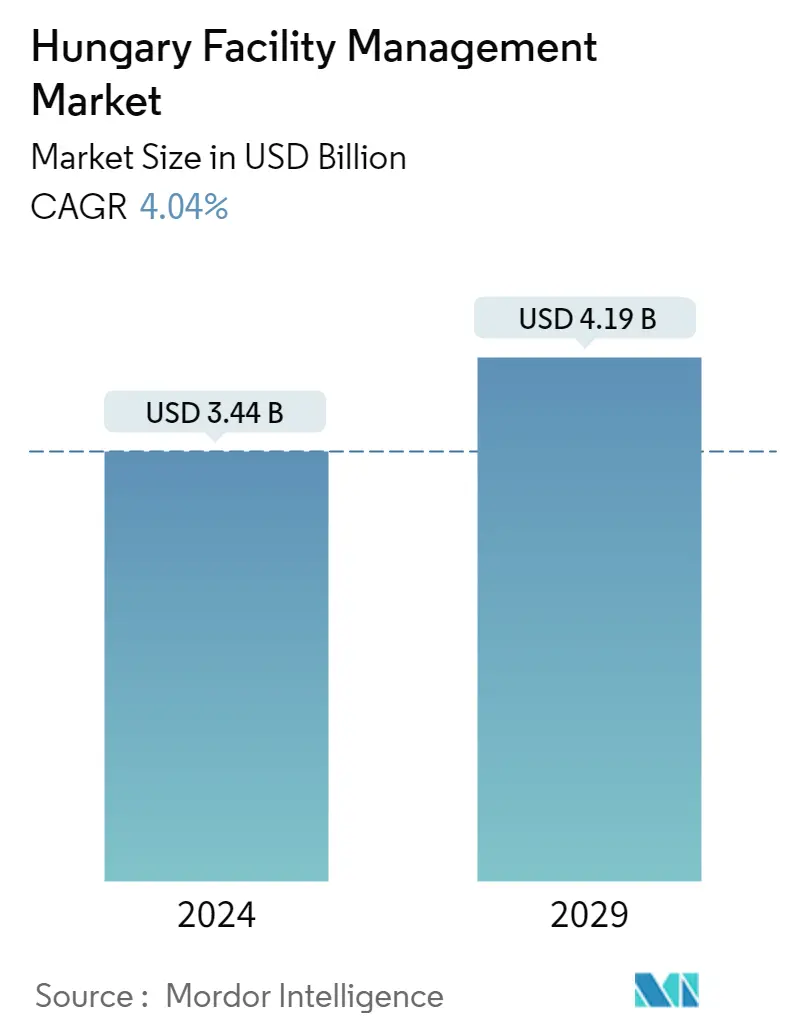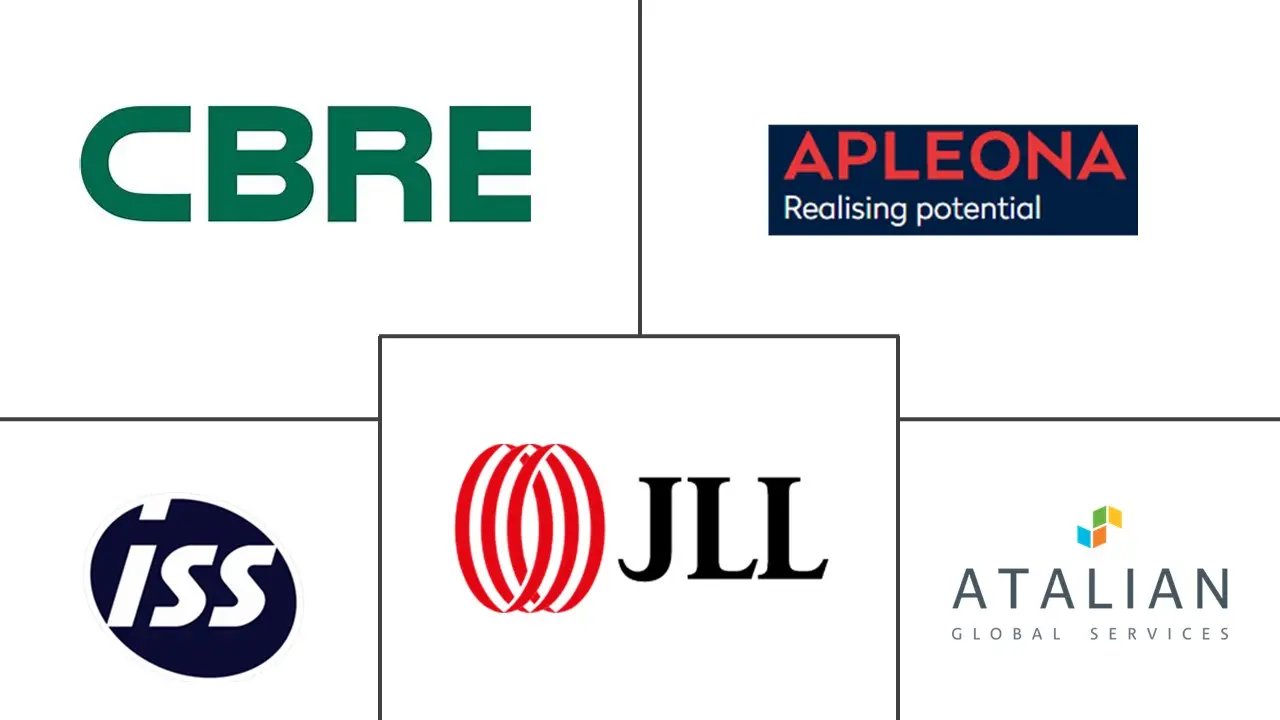Market Size of Hungary Facility Management Industry

| Study Period | 2019 - 2029 |
| Base Year For Estimation | 2023 |
| Market Size (2024) | USD 3.44 Billion |
| Market Size (2029) | USD 4.19 Billion |
| CAGR (2024 - 2029) | 4.04 % |
| Market Concentration | Low |
Major Players
*Disclaimer: Major Players sorted in no particular order |
Hungary Facility Management Market Analysis
The Hungary Facility Management Market size is estimated at USD 3.44 billion in 2024, and is expected to reach USD 4.19 billion by 2029, growing at a CAGR of 4.04% during the forecast period (2024-2029).
- Hungary has one of the most advanced markets for facility management services, with the sector based on integrated contracts provided by major vendors across continents and borders. Meanwhile, small local competitors focus on single contracts and single-service solutions. Additionally, there are increasing opportunities to use facility management and corporate real estate in innovative ways.
- Over the last decade, many service providers operating in the country have prioritized expanding their presence to profit from the growing demand for facility management, particularly with the current trend favoring the outsourcing of non-core activities. Given the opportunities, the country has seen an increase in the number of possibilities to leverage facility management and corporate real estate in innovative ways.
- The medical technology sector is one of Hungary's most historic economic sectors, with over 100 years of well-recognized innovation, highly specialized technological development, and significant exports to the worldwide market. Some Hungarian enterprises with cutting-edge technology and products have acquired international prominence. An increasing number of creative local SMEs and some multinational medtech manufacturers are taking advantage of Hungary's favorable environment and productive workers. Nearly 150 enterprises in Hungary are involved in export-driven medical manufacturing.
- Facility management involves maintaining an organization's most important and valuable assets, such as real estate, machinery, buildings, and other settings that house workers, output, inventory, and other operational components, contributing to the business's bottom line.
- The substantial outsourcing operations conducted by government organizations in the market have resulted in public sector saturation. Public sector organizations have utilized contract extensions to retain long-term partnerships with facility management players. However, increasing market rivalry has affected the profit margins and growth of current providers. The intense competition among vendors has commoditized FM services in the country, which is expected to challenge the market's growth.
- The pandemic had a tremendous impact on the facilities management industry, resulting in a substantial shift in the operations, strategies, and functions of facility managers inside organizations. In the post-COVID-19 future, there is an increased demand for transformation, creative solutions, and unique planning strategies. Since the emphasis has shifted toward higher hygiene-related rules, better workplace safety and cleanliness, and the development of a digitized work environment, sourcing and procurement play an essential role in the post-COVID-19 transformation, recovery, and restart of the facilities management industry.
Hungary Facility Management Industry Segmentation
Hungary's facility management market is defined as facilities management encompassing various disciplines and services that maintain the operation, comfort, safety, and efficiency of the built environment, including buildings, infrastructure, and property. Facilities management encompasses a number of parameters, including operations and maintenance. FM includes services such as building maintenance, maintenance operations, utilities, waste services, security, and others.
The Hungary facility management market is segmented by type of facility management (in-house facility management, outsourced facility management (single FM, bundled FM, integrated FM), offerings (hard FM and soft FM), end-user (commercial, institutional, public/infrastructure, industrial, and other end-users). The market sizes and forecasts are provided in terms of value in (USD) for all the above segments.
| By Type of Facility Management | |||||
| In-house Facility Management | |||||
|
| By Offerings | |
| Hard FM | |
| Soft FM |
| By End User | |
| Commercial | |
| Institutional | |
| Public/Infrastructure | |
| Industrial | |
| Other End-Users |
Hungary Facility Management Market Size Summary
The facility management market in Hungary is characterized by its advanced and integrated service offerings, driven by both international and local players. Major global vendors dominate the market with comprehensive contracts, while smaller local competitors focus on niche, single-service solutions. The sector is experiencing a shift towards outsourcing non-core activities, which has spurred growth and innovation in facility management and corporate real estate applications. The medical technology sector, with its rich history of innovation and significant exports, plays a crucial role in the economy, with many local SMEs and multinational companies leveraging Hungary's favorable business environment. The demand for facility management services is further fueled by the country's focus on sustainability, leading to increased interest in energy-efficient and smart building solutions.
The industrial sector in Hungary, encompassing manufacturing and logistics, is a significant driver of demand for facility management services. The country's strategic location, robust transportation infrastructure, and competitive labor costs make it an attractive hub for industrial activities. This has led to substantial investments in logistics and manufacturing facilities, increasing the need for facility management services. The market is fragmented, with major players like CBRE Group, Apleona GmbH, and ISS Global adopting strategies such as partnerships and acquisitions to enhance their service offerings. These companies are increasingly focusing on smart and predictive maintenance solutions to optimize facility operations. The ongoing development of smart buildings and energy-efficient solutions is expected to further boost the demand for facility management services in Hungary.
Hungary Facility Management Market Size - Table of Contents
-
1. MARKET INSIGHTS
-
1.1 Market Overview
-
1.2 Industry Attractiveness - Porter's Five Forces Analysis
-
1.2.1 Bargaining Power of Suppliers
-
1.2.2 Bargaining Power of Consumers
-
1.2.3 Threat of New Entrants
-
1.2.4 Threat of Substitute Products
-
1.2.5 Intensity of Competitive Rivalry
-
-
1.3 Impact of COVID-19 on the Facility Management Industry
-
-
2. MARKET SEGMENTATION
-
2.1 By Type of Facility Management
-
2.1.1 In-house Facility Management
-
2.1.2 Outsourced Facility Mangement
-
2.1.2.1 Single FM
-
2.1.2.2 Bundled FM
-
2.1.2.3 Integrated FM
-
-
-
2.2 By Offerings
-
2.2.1 Hard FM
-
2.2.2 Soft FM
-
-
2.3 By End User
-
2.3.1 Commercial
-
2.3.2 Institutional
-
2.3.3 Public/Infrastructure
-
2.3.4 Industrial
-
2.3.5 Other End-Users
-
-
Hungary Facility Management Market Size FAQs
How big is the Hungary Facility Management Market?
The Hungary Facility Management Market size is expected to reach USD 3.44 billion in 2024 and grow at a CAGR of 4.04% to reach USD 4.19 billion by 2029.
What is the current Hungary Facility Management Market size?
In 2024, the Hungary Facility Management Market size is expected to reach USD 3.44 billion.

